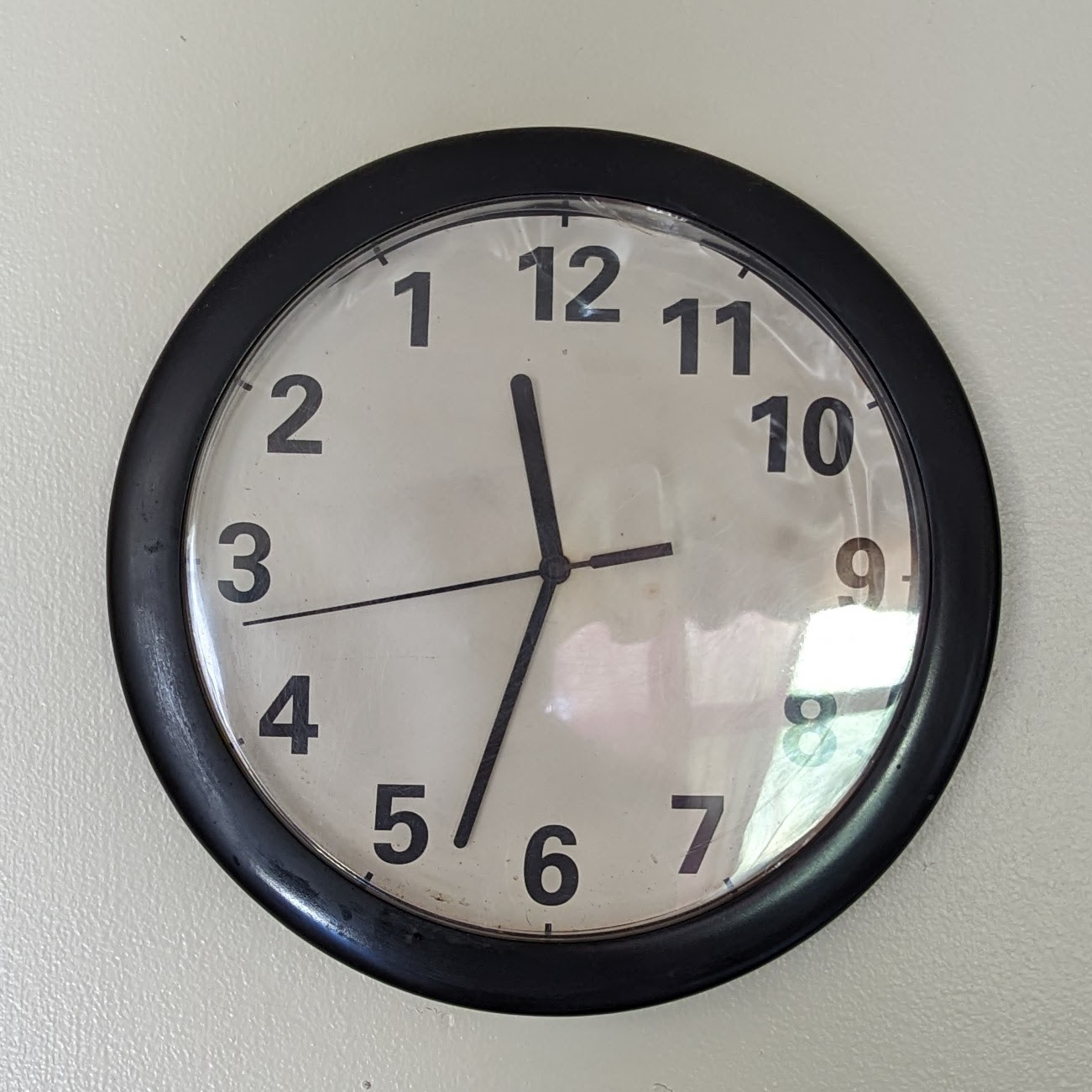Was there an alternative adjective to “clockwise” other than “the rotation you take around left hand”?
Also, how did all watch companies around the world agree on what the direction of “clockwise” is?
“Sunwise”, and for the exact same reason.
Clocks go clockwise because their predecessors did. What were their predecessors?
Sundials.
How does the shadow go around a sundial? Well, sunwise, of course.
Counterclockwise, as said in another comment, was “widdershins”, from a Middle Low German phrase meaning “against the way”.
Widdershins needs to make a comeback. It’s a cool word
Also turnwise. Also we need to switch from a globe to a disk on the backs of four cosmic elephants, who are themselves on the back of a giant turtle
I am trying to picture it, but I think the sunwise convention only works in the Northern hemisphere.
Yep - in the northern hemisphere a sundial shadow will move from west to east in a clockwise fashion; in the southern hemisphere it still goes west to east but does so moving anticlockwise.
And if I’m thinking about this correctly, people between ~20N and ~20S latitudes will have it reverse throughout the year and and sometimes be a straight line.
Wait, it’s all anglo-centric?
Always has been.
🌍🏴🧑🚀🔫🧑🚀
I find it interesting that in Swedish the opposite of sunwise is “motsols”, i.e. counter sunwise or literally “against the sun”. Sunwise is called “medsols”, lit. “with the sun”.
ILJM.
I’ve just find (in wiktionary) the word “moonwise”, meaning antisunwise/counterclockwise. But the moon moves the same way as the sun does. So is there some deeper meaning based off of some long-term patterns in lunar movement, or is it just simple antagonism sun×moon?
That’s what it appears to be. This is supported somewhat by the term “moonwise” not having a lot of historical usage, leading me to believe that it came along much later by someone who wanted a related antonym.
The only bit about the moon that seems to travel right to left are it’s phase changes, and even that is because we’re outside the rotation and watching along it’s horizontal plane. You’ll see the same thing with anything spinning clockwise in front of you: the closer edge goes right to left, the farther edge goes left to right.
You just made my brain click. I’ve always wondered why clockwise rotation around a vertical axis was commonly agreed. I have never seen a mechanical- or electrical clock installed flat on the ground. So why would we assume that the clock isn’t in the ceiling facing down, which would reverse the direction?
But now that you mention it in the context of a sundial, it seems so obvious that the clock is just an extension of that, making the sun and clock a common reference.
But that bids the question if they have another term for it in the southern hemisphere.
It’s been very difficult to find an answer for this, and I suspect it’s because most of the southern hemisphere is water, and most of the rest of it was colonised by people from the northern hemisphere. As of right now, I couldnt say if there simply weren’t words for that kind of rotational motion or if my google-fu simply isn’t strong enough.
The best answer I’ve been able to find is from Indonesia, which is equatorial. The word “sunwise” translates into a phrase “from left to right” via Google Translate, but that may just be an artifact of machine translation.
I didn’t even consider equatorial countries. That’s interesting as well. Depending on the season, the literal “sunwise direction” would change, while spring- and autumn equinox wouldn’t translate to any rotation around a vertical axis.
I used to be a swing dance instructor, and describing rotation as “to the left” or “to the right” always seemed a bit more natural and understandable for the general participant.
Turnwise and widdershins. I read it in a book once.
Sunwise, as it was based on the movement of the sun during day (in the Northern hemisphere). As watch faces were modelled after sundials, sunwise and clockwise describe the same direction.
Turnwise is a word invented by Pratchett for a book, but it’s clearly based on sunwise. He also used widdershins in his book, which is indeed the unmodified antonym to sunwise.
Not just any book. The discworld series. It’s the direction the disc rotates! He has so many easy to miss spots of genius. Amongst many easy to see spots of genius
I have found my people.
Deosil (sunwise) was the opposite of widdershins (against the usual). Both had a wide range of uses too, not just directionality.
Well, clocks are just mechanical sundials. Before clockwise, there was sunwise (or deosil), and clocks’ movements are based off of the movement of a shadow across a sundial.
does that mean that “clockwise” in the southern hemisphere is backwards?
Yes, because of the Coriolis effect (/j)
No, because the earth is still rotating the same direction in the southern hemisphere
I read this article and I’m more confused now lol
https://en.wikipedia.org/wiki/Sundial#In_the_Southern_HemisphereEDIT: The last sentience sums it up well tho:
On horizontal northern-hemisphere sundials, and on vertical southern-hemisphere ones, the hour marks run clockwise.
Northern sundials (both vertically mounted and horizontal versions) need to be pointed North, whereas Southern sundials need to be pointed South. The article is stating that Southern horizontal versions can be mounted vertically in the Nothern hemisphere but must be pointed South. I hope that helps, I had to re-read it a few times, myself.
Well well, learn something new everyday.
Pretty weird to think about. And about them having to either face their relevant poles or the equator for them to work equivalently
Imagine you’re in the Northern Hemisphere and you face east toward the rising sun. Over the course of the day, the sun will seem to move to the south, and then set in the west. This forms a “sunwise” turn, which is what we now call “clockwise” because we made clocks in imitation of sundials.
In Swedish it’s called medsols and motsols. The iteral translation is with the sun and against the sun.
Is there a large perceptible pronunciation difference? Because if not med and mot being opposites seems like it’s rife for sitcom hijinks
There is, yeah, /meːd/ and /muːt/
In czech, we have a phrase “jak sa kráje chleba” (same way as a bread is sliced). Problem is, that (at least in my social group) nobody knows, wether it means clockwise or anticlockwise, as everybody slices the bread differently.
same way as a bread is sliced
Haha interesting, but how do you slice bread by rotation? it’s up to down. That’s how you cut stuff.
- Grip the bread vertically to your chest.
- Start cutting in direction from the front to the back.
- Slowly rotate the bread, so you cut the crust only in one point (the tip of the knive moves through already cut bread).
It may be easier to see it with a short knive.
Turnwise and widdershins
GNU Terry Pratchett
I always heard it as ‘deosil and widdershins’
To your second question, the direction of clockwise is mostly influenced by sundials. In the northern hemisphere the shadows move in a clockwise direction, and so the early clocks made in the northern hemisphere mimicked that. In the southern hemisphere it’s naturally reversed, but because so much of that hemisphere is either empty ocean or colonized lands, the clocks move in the same direction. Bolivia had a sort of flash in the pan moment in the news about a decade back for reversing their clock direction on a big central clock (think like big ben) as a way of staking their independence from a colonial past.
On the first question, I have no idea. But in Sweden they use terms that translates to “with the sun” and “against the sun” but I don’t remember what they are without googling it.
Semi related: QI uploaded this bit the other day about an aboriginal tribe that can flawlessly pinpoint north/east/south/west.
This turned out to be a surprisingly fascinating question lol.
I have the feeling that the direction of the water in the toilet when flushing plays an important role here.
The first mechanical clocks were invented around 1300. The first flushing toilet was 1775.
Yup. That’s definitely “down”.
A guy I know owns this clock, which basically proves that everything in life is pointless and arbitrary:

Weird, this feels easier to read. Less grating somehow.
You left-handed?
Nope. Right handed. But AuDHD like there’s no tomorrow…
Also why the seemingly arbitrary graduations, 24 hours, 60 minutes, 60 seconds. If it was say 10 hours in a day, 100 minutes in an hour, 100 seconds in a minute, seconds would be close to the same amount of time. Same with latitude and longitude, why 360 degrees in a circle with 60 minutes in a degree and 60 seconds in a minute.
These numbers aren’t arbitrary, they are from different base numbering systems.
60 can easily divide by 2, 3, 4, 5, 6, and 10.
12 can easily divide by 2, 3, 4, and 6 (notice how much overlap there is).
10 only divides easily by 2 and 5. Common fractions like 1/4 or 1/3 now require decimals.
Basically, base 12 and base 60 make it significantly easier to think and work in common fractions.
It is also historically significant, as base 12 used to be more common than modern base 10. Our timekeeping system dates back to the ancient Babylonians, who worked in base 12. This influence is still felt in other places, such as the fact that eleven and twelve have unique names in many languages rather than following the same pattern as everything that comes after them.







